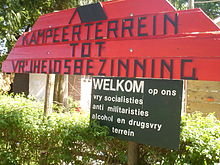Anarchism in the Netherlands
[1] Its roots lay in the radical and revolutionary ideologies of the labor movement, in anti-authoritarian socialism, the free thinkers and in numerous associations and organizations striving for a libertarian form of society.
During the First World War, individuals and groups of syndicalists and anarchists of various currents worked together for conscientious objection and against government policies.
In the province of Friesland, for example, there were seventeen "socialist pastors" around 1932, fourteen of whom were members of the Social Democratic Workers' Party (Dutch: Sociaal-Demokratische Arbeiderspartij, SDAP).
[4] One of the pioneers of socialism and anarchism in the Netherlands was the Christian socialist Leendert de Baan, a pastor and advocate of conscientious objection.
[7] The spokesman for the "red pastors" in the Dutch province of Friesland, Jan Anthonie Bruins Jr., came to socialism through Ferdinand Domela Nieuwenhuis.
Among other things, he was active in the "Arbeiter-Jugend" and the Nederlandsche Vereeniging tot Afschaffing van Alcoholhoudende Dranken ("Dutch Association for the Abolition of Spirits").
As a pacifist and member of the Christian anti-militarist association Kerk en Vrede ("Church and Peace"), he had a large following among socialist workers.
[14] Sjoerd Si (e) brens van Veen, one of the first Christian socialists, was a follower of Nieuwenhuis and especially active in the province of Friesland.
In 1907 he was co-founder of the Bond van Christen-Socialisten (BCS), editor of the Opwaarts magazine and board member of the Religieus-Socialistische Verbond ("Religious Socialist Association") and of the Instituut voor Arbeidersontwikkeling (literally: “Institute for Workers' Development”; IvAO).
[19] Josef Alexander Cohen called out "the gorilla king" in public and was sentenced to six months in prison for lese majesty.
[20][21] Nieuwenhuis was also sentenced to one year in prison for lese majesty, on the basis of an April 1886 article in the magazine Recht voor Allen, which was directed against the monarchy.
The strikes of 1888 were the beginning of organized workers' uprisings in the Netherlands and the village was considered a stronghold of radical socialism and anarchism.
During a strike in 1888, the first small trade union was founded in Friesland, De Eendracht, which worked regionally and had Bruin Tjibbes Bruinsma as its chairman.
This association arose out of an interest in founding an organized freethinker movement and, from 1879 onwards, focused on issues such as emancipation, universal suffrage, anti-militarism, homosexuality and the separation of church and state.
In a major article in Recht voor Allen in January 1880, written by Nieuwenhuis, reference was made to the cooperatives in Belgium.
The initially revolutionary-socialist party the Social Democratic League (Dutch: Sociaal-Democratische Bond, SDB)[30] was founded in 1881 as an amalgamation of some regional associations and was mainly active in Friesland.
[31] In 1893 the first major trade union called the National Labor Secretariat (Dutch: Nationaal Arbeids-Secretariat, NAS) was founded, along with its magazine De Arbeid.
[32] The chairman of the NAS, Bernardus Lansink jr., founded the Regional Federation of Revolutionary Socialists (Dutch: Landelijke Federatie van Revolutionaire Socialisten, FRS) together with communist anarchists in 1905.
The anarchists within the NAS took it from Lansink Jr., propagandist and editor of the magazine De Syndicalist, after it was discovered that he was a member of the Socialist Party (SP).
After the Social Democratic Workers' Party (Dutch: Sociaal-Demokratische Arbeiderspartij, SDAP) was founded in 1896, there was a split within the Socialist League.
In November 1926, it introduced the term "anarcho-syndicalisme" to the Netherlands, together with Albert de Jong when he founded the Gemengde Syndicalistische Vereeniging.
[40] In 1937, Anton Levien Constandse and fifteen groups founded the Federation of Anarchists (Dutch: Federatie van Anarchisten, FAN) to support the Federación Anarquista Ibérica (FAI).
These were mainly aimed at falsifying documents, bringing German and Dutch anarchists in direct danger to safety, printing and distributing illegal newspapers and pamphlets, and helping the Jewish population.
In 1943, Mazirel was one of the organizers of the attack on the Amsterdam population register in the Apollobuurt district, to destroy the personal information of politically persecuted people.
After some misgivings, the FAN dissolved, but was continued under a new name in 1954 as the Federation of Free Socialists in the Netherlands (Dutch: Federatie van Vrije Socialisten in Nederland, FVS).
Initiated by the anarchist philosopher Roel van Duijn, the non-smoking activist Robert Jasper Grootveld, Rob Stolk, Peter Bronkhorst and the inventor Luud Schimmelpennink.
Their starting point was anarchism, where they looked for alternatives to problems that existed in society, for example in the workplace, in schools, the prison system and to take initiatives for tenants and the squatter movement.
Both the AGN and the AK-Utrecht affiliated to the Free Union,[46] an anarchist organization with groups in Utrecht, Amsterdam and Nijmegen,[47] among other cities.
The ASB wanted a stronger focus on industrial action and had members in Utrecht, Twente, Amsterdam, Brabant, Rotterdam and The Hague.
The ASB saw itself as a workers' organization with the aim of abolishing capitalism and the state, and in this sense followed a classic anarcho-syndicalist line.





